Burn Hole 1961 (Tate T13407) marks Peeters’s move from the ‘hot’ world of abstract, informel painting to the ‘cool’ one of neo-dadaism, where works produced by assemblage and appropriation prevailed, and ideas were valued as much as art objects themselves. Although Burn Hole was created using an intense heat source, the icy white of the plastic sheet registers visually for us how that rapid action, and the ensuing destruction of the support, has been frozen in time. The kind of gestural painting Peeters had practised in the 1950s was premised on the visibility of the artist’s hand in the making of the work. Here, it is only the sooty deposits on Burn Hole that retain some of that sense of life and movement, and furthermore, the exchange of brush for Bunsen burner, candle or cigarette as a mark-making tool meant that even physical pressure on the support was no longer needed to produce a result.
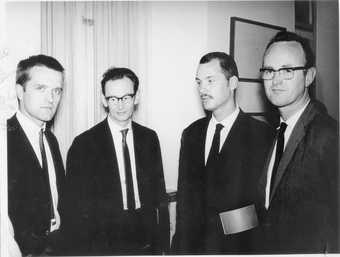
Fig.1
Jan Henderikse, Jan Schoonhoven, Armando and Henk Peeters at the Städtisches Museum, Trier, October 1961
© Herman Bartels
The accompanying switch from the Nederlandse Informele Groep to Nul similarly produced a change of image for the artists involved. A photograph of Jan Henderikse, Jan Schoonhoven, Armando (Herman Dirk van Dodeweerd) and Henk Peeters at the opening of the exhibition Avantgarde 61 at the Städtisches Museum in Trier in October 1961 shows that they had by then adopted a uniform mode of attire: fashionable dark suits, plain white shirts and thin dark ties (fig.1). Art historian Antoon Melissen has connected this look directly to the new modes of artistic production the group was pursuing:
The Nul artists aimed to shed the stereotyped image of the bohemian in a painting smock and had a fresh attitude towards the consumer society, quite at odds with the artistic scene of the early 1960s. Nul was a search for new relationships between art and reality, with at its base the rejection of uniqueness, authenticity and decorative attractiveness in the traditional sense of the word. The group reduced the multi-coloured to the monochrome and opted for repetition, seriality and the directness of everyday materials and objects.1
The idea that ‘seriality’ could extend to the artists’ own selves was picked up on in a review of the Trier exhibition, which commented on the ‘depersonalised’ character of much of what was on display.2 However, in a comment on his pyrographies made in the catalogue of the 1965 Nul exhibition at the Stedelijk Museum, Amsterdam, Peeters described the connection between the works and his own identity slightly differently. Written in a rather oblique note form, he stated: ‘Pyrography. Parting with the work and the viewer his self-guided game. The fire writes my handwriting (first pyrographies date from 1959 – shown in ’60 in the Stedelijk – first on linen, thereafter in white plastic and foam rubber).’3
Leaving aside for the moment Peeters’s need to establish the priority of his early adoption of fire as a medium (which may relate to his interactions with the French artist Yves Klein), it is worth paying close attention to the apparent contradiction in this statement between the first and second lines.4 Peeters begins with the idea that pyrography takes the work out of his hands; this is quite literal in the Dutch words used: uit handen geven. The touch that a brush, as an extension of the artist’s wrist and hand, would traditionally make on a surface is absent, replaced by the action of a heat source which the artist has difficulty controlling. The fire is the active agent here, not the artist. The result is not only fundamentally non-expressive for the artist; the viewer is also relieved of the need to discover personality in the work. However, the next part of the statement suggests the complete opposite; through the use of fire, Peeters is able to put something of himself directly into the work, in this case his handwriting (handschrift). Even more than painting, then, pyrography transmits the artist’s unique identity into the object. As Peeters explained in a later interview, pyrography was a step towards handing over the making of a work to someone else completely. While others could follow the process, its unpredictability meant that he would still need to judge whether a work counted as ‘his’ or not.5
The adoption by Peeters and his fellow Nul artists of a sartorial ‘look’ that resembled their art (reduced to black and white, made from contemporary materials, manufactured rather than tailored) may have been more than a clever, photogenic marketing strategy. The reduction of their individual identities to a single, collective one says something deeper about the way they perceived the connections between the works and their physical selves, despite the anti-figurative rhetoric of Nul art theory.
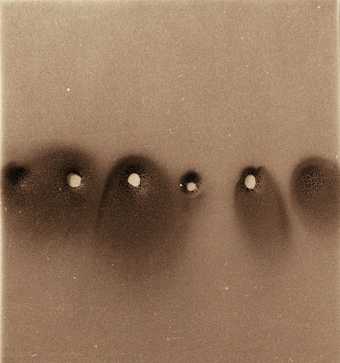
Fig.2
Henk Peeters
59–18 1959, reconstructed 1997
Melted foam on soft board
800 x 750 mm
Collecties Rijksdienst voor het Cultureel Erfgoed, Amersfoort
© Estate of Henk Peeters
An association between Peeters’s pyrographies and bodily form has been drawn by art historian Marga van Mechelen. In a detailed analysis of one of Peeters’s very first works of this kind, 59–18 from 1959 (fig.2), van Mechelen describes how the work was reproduced in the first issue of the publication de nieuwe stijl (The New Style) in 1965, edited by Armando, Peeters and the poet Hans Sleutelaar.6 There it was illustrated across a double page without borders. Due to the proportions of the publication, the outer two of the six horizontally arranged burn marks were pushed right to the edge and slightly cropped, and the overall composition was shifted slightly to the right to accommodate the centrefold exactly between the two innermost holes. Unlike Burn Hole, the plastic foam sheet of 59–18 was not stretched but later mounted by the artist on a soft board. He placed a strip of white material on the back, which meant that the holes did not show up as shadowy voids but as white areas surrounded by black auras.7 As van Mechelen notes, the effect is such as to produce ‘something unintentionally “figurative”: the association with two pairs of breasts and four nipples’.8 While that directly representational effect is perhaps unfortunate and was possibly undesired by Peeters, he was otherwise keen to play up the sensuous nature of his practice. In his 1965 Nul catalogue statement referred to above, Peeters directly followed the account of pyrography with a section on ‘tactilism’, which he described as the production of objects ‘more readily interesting for other sense organs than the eye. Above all touch is a scarcely exploited sense.’9 He then went on to mention a failed plan for an exhibition for the blind (on which he collaborated with Bernard Aubertin) and concluded the whole entry with a section on ‘the erotic’, to which, in his view, all sensation was directed.
It would be perhaps overly simplistic to reduce the visual interest of Burn Hole to the straightforward product of bodily associations with orifices and penetration. However, it is worth thinking further about Peeters’s very quick move in 1959 from burning holes in canvas to the use of PVC sheeting. The application of a heat source to plastic was a far more transformative process than was the case with cotton. It involved stages of melting and liquefaction that highlighted the malleable properties of the material. Although far more of a cultural than a natural product, PVC behaves more like skin than cotton does; it has elasticity to it and the ability to reform after heating, rather than fray. The kind of PVC that Peeters used for Burn Hole also has a sheen that is closer to the gleam of skin than dull canvas and is potentially warm and springy to the touch, despite the coolness of its titanium white colouration.
It is for these kinds of material qualities that PVC became a popular material for clothing during the 1960s and remains associated in the popular imagination with forms of fetish-wear. As David Kunzle has described, such clothing is often combined with body-sculpting.10 Not only can it produce a taut, smooth second skin, the shiny, sheer or even sometimes ‘wet-look’ of the material on the outside is matched by the effect it produces on the inside, raising body temperature and applying pressure, all of which can be experienced by the wearer as erotic. In 1966 Peeters supervised some of his students at the academy in Arnhem in the production of a range of clothing using new synthetic materials, such as reflective nylons and plastics.
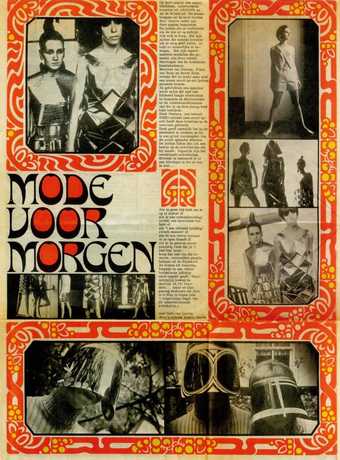
Fig.3
First page of Hitweek, no.36, 20 May 1966, showing clothing designs by Henk Peeters’s students
Collection of RKD – Netherlands Institute for Art History, The Hague
One outfit stands out for particular mention in our context: a women’s playsuit made out of what appears to be PVC (see the upper right corner of fig.3). The item has been designed with a broad crossover strap starting at the waist that leaves the model’s navel exposed in a triangle. The hole on display here draws attention away from more obvious erogenous areas to the very centre of the body and to the ultimate mark of humanity, the first wound of birth. The garment produces a fetishistic displacement of erotic interest by rotating the pubic triangle by 180 degrees to focus on a different hole, while the contours of the model’s body are otherwise smoothed into a resistant shell. It is tempting to think about a comparison to the structure of Burn Hole and its gendered associations; it is at once potentially vaginal, with the eye continually seeking a route in and through, but at the same time unremittingly vertical, a flat surface across which vision is dispersed.
Peeters’s comments concerning the sensuous and the erotic need to be seen in the light of his wider political and social engagements. He never made a secret of his long-standing commitment to openness in the area of sexuality. When Peeters took part in a counter-cultural conference in Maastricht in 1967, he was there not so much for his artistic practice as his work for the Nederlandse Vereniging voor Seksuele Hervorming (The Dutch Association for Sexual Reform).11 From the beginning of the decade he worked on behalf of the organisation as an advisor, primarily on its telephone helpline, and was well acquainted with leading figures in the campaigns to promote birth control and legalise abortion.12 Peeters’s wife, Truus Nienhuis, took part in the first trial of the contraceptive pill in 1961. According to Peeters’s own account, he and Nienhuis only married in order to secure a housing contract, and, despite an otherwise outwardly conventional family life – they had three children together – they maintained an open relationship, each having other sexual partners. Peeters credited the controversial psychoanalyst Wilhelm Reich as an important influence, who was famous for his theories concerning the importance of orgasm. According to Peeters, it was from Reich that he learned to perceive connections between political and sexual liberation.
Peeters’s contestation of conventional sexual relationships has oblique but important connections to the artistic strategies he pursued and his decision to abandon painting. At the time he created his pyrographies and Burn Hole, Peeters was also considering ways of making art through the use of appropriated and found objects. Writing to Hans Sleutelaar in October 1960, he mused on what he referred to as the ‘distance from the painting’, the hands-off approach to art making that typifies Nul. Yves Klein remained an important example but Peeters had concerns about Klein’s ‘anthropometry’ paintings, the works produced by female models covering their bodies in Klein’s signature blue paint and imprinting themselves on canvas. Despite Klein’s relinquishment of the creation of the works to the models – in the famous performance of anthropometry painting in Paris in March 1960, Klein’s immaculate suit remained unblemished while the naked, paint-splattered models dragged each other around on the canvas on the floor – Peeters worried about its residual expressive content manifested in Klein’s power over his models. ‘I want to go further … have pictures manufactured or ‘adopt’ them, ones that are made by their maker in my spirit,’ he wrote.13
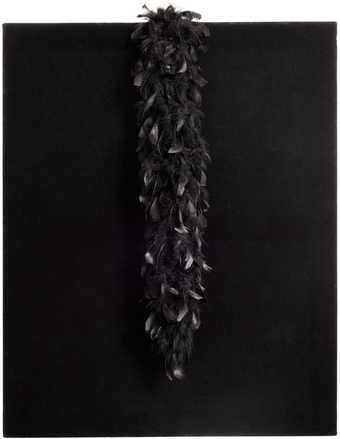
Fig.4
Henk Peeters
Zwarte boa 62–36 1962, remade 1984
Kunstruimte Wagemans, Beetsterzwaag
© Estate of Henk Peeters
It took a while for Peeters to find things to ‘adopt’ and ultimately these objects were discovered through his preference for certain materials. In 1961 he began making ‘flock pictures’, initially using cotton wool and then later nylon card sliver. These were followed quickly by others incorporating synthetic fur and then, by 1963, feathers and hair (both real and fake). The importance of touch, of softness, suppleness and lack of defined edge is readily apparent, as well as an attraction to materials used in bodily adornment, disguise and clothing. Zwarte boa 62–36 (Black Boa 62–36), originally made in 1962 and then remade in 1984, is, as its title suggests, a black feather boa, which Peeters hung vertically in the centre of a black canvas (fig.4). While culturally feminine, the presentation of the floppy boa not draped but bolt upright repeats the ambiguously gendered structure of Burn Hole. For a 1964 Nul/Zero exhibition at the Gemeentemuseum Den Haag, Peeters planned to construct what he called a ‘Beatle-Column’, which was supposed to be two vertical rollers covered in floppy plastic hair between which visitors had to squeeze, rather like a car wash.14 The ‘mop top’ haircut popularised by The Beatles had allowed men of the time to exchange their carefully controlled, Brylcreemed quiffs for a much softer, shakeable, and sexually ambiguous look. Once again, the obvious vaginal associations of the work – entering the exhibition would have been something akin to a birthing experience – are combined with distinctly masculine traits.
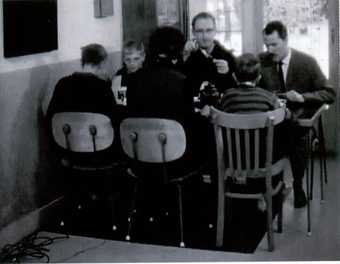
Fig.5
Henk Peeters interviewed at breakfast by Armando for the television programme ‘Signalement’, broadcast by VARA on 29 December 1963
Around the same time, Peeters exchanged his identikit Nul suit for an altogether different look to make his first television appearance, on the infamous ‘Signalement’ programme on contemporary art that was broadcast in the Netherlands in 1963 (fig.5). As part of the programme, a brief ‘interview’ with the artist was conducted by Armando at Peeters’s family home. The joke of the scenario is that Peeters appears rather unexpectedly having just got out of bed. Showing no signs of embarrassment to be appearing on television in his dressing gown and, while continuing to speak to Armando, Peeters joins his wife and children at the breakfast table. Was this simply a Nul reflection on the connection between art and reality? Rather than seeing Peeters alone in a studio, were viewers supposed to register how he was part of a larger family structure and that making art was not just his vocation but part of his responsibility to put breakfast on the family table? Or, just as Nul wished to engage with the world in the most direct ways possible, was the banality of the setting, the unremarkable experience of eating breakfast important? Probably all of these are true, as well as the presentation of yet another alternative to the bohemian image of the artist discussed earlier. Even when clarifying his connectedness to others, Peeters, in his state of semi-undress, did not take on the role of ‘master of the house’.
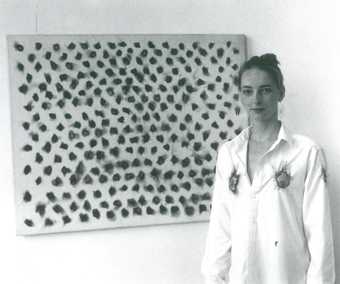
Fig.6
A model wearing Henk Peeters’s pyrography shirt while standing next to 60–13 1960, Galerie Coumans, Utrecht, 1987
© Estate of Henk Peeters
Clothing continued to play a role in Peeters’s later works and in 1987 he exhibited his Overhemdenprojekt (Shirts Project) at a gallery in Utrecht. This featured shirts adorned with feathers and also ones with burn holes. A contemporary photograph makes a direct connection to the earlier pyrographies and invites analysis. It shows a female model wearing a shirt with holes burned in it standing next to 60–13 from 1960 (fig.6). The position of the holes reveals the model’s nipples in a manner that directly recalls van Mechelen’s description of the photographic presentation of 59–18. Does this reframe pyrography as being closer to the sort of control over the female model that Peeters had previously questioned in Klein’s anthropometries? Could we imagine the action of a flame on a plastic surface to be equivalent to sadistic power over yielding skin? This would not really equate to the politics of ‘letting go’ of the work that was outlined in Peeters’s 1965 description of pyrography.
To see the alignment between these two moments in 1960 and 1987, we need to perceive how the plain, white shirt that the Nul artists adopted in 1961, like the smooth white plastic of Burn Hole, has had its armour pierced. The affectless image of Nul and the diffident masculinity paraded by its uniformly dressed members has been exposed here as erotically invested. The oversized shirt worn by the model does much less to emphasise, project and eroticise her breasts than many conventional items of women’s clothing. In fact, its effect is to reduce their size visually, to separate them rather than press them together, and to draw most attention to what is common to both the female and male anatomy, the nipple. By wearing the shirt, the model is becoming a Henk Peeters, and maybe even becoming Henk Peeters himself. This is a more materialised form of the imaginative work that the viewer brings to Burn Hole, an investment of an otherwise decidedly inert object with life.
